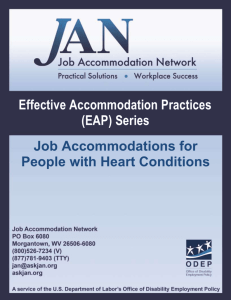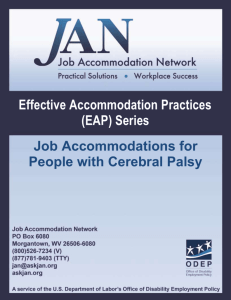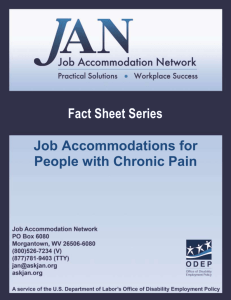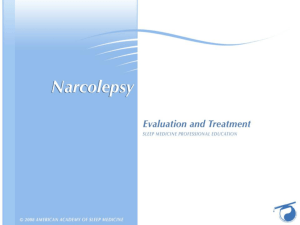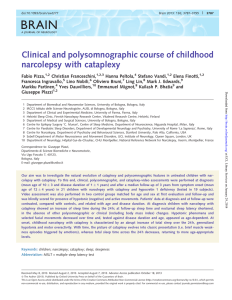Effective Accommodation Practices Series: Job Accommodations for
advertisement
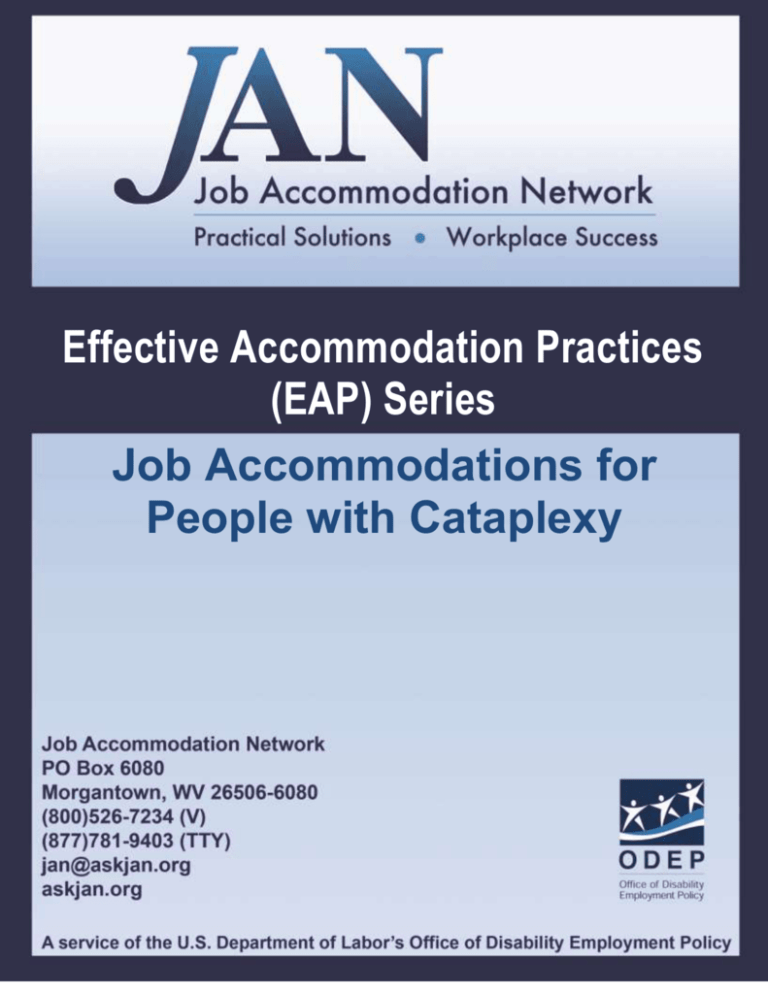
Effective Accommodation Practices (EAP) Series Job Accommodations for People with Cataplexy JAN’S EAP SERIES JOB ACCOMMODATIONS FOR PEOPLE WITH CATAPLEXY Cataplexy is the sudden loss of voluntary muscle tone or temporary paralysis that is often triggered by extreme emotion, such as laughter or fear. Cataplexy by itself is considered a rare disease, but also occurs in 70% of all people with narcolepsy (NINDS, 2013). Most episodes are short in duration, lasting a few seconds up to five minutes. These episodes tend to have few, if any, residual effects. During a cataplectic attack the person will remain conscious; however, the person may experience jaw dropping, which can cause speech limitations, or eyelids drooping, which can interfere with vision. Other symptoms may include balance issues, upper extremity weakness, and/ or collapsing. The following is an overview of some of the job accommodations that might be useful for symptoms of cataplexy. For a more in depth discussion of accommodations, access JAN's publications at AskJAN.org/media/atoz.htm. To discuss an accommodation situation with a consultant, contact JAN directly. Fatigue/Weakness: Reduce or eliminate physical exertion Schedule periodic rest breaks away from the workstation Allow a flexible work schedule and flexible use of time Implement ergonomic workstation design Use anti-fatigue matting on the floor Allow alternate work settings, such as work from home Fine Motor: Implement ergonomic workstation design Provide writing aids, page turner, book holder, etc. Provide alternative computer and telephone access Gross Motor: Accessibility: Provide a closer parking space Reduce walking or provide mobility aid Provide an accessible route of travel to other work areas Move workstation close to other work areas, office equipment, and break rooms Make sure materials and equipment are within reach range Driving: Pair employee with co-worker who can drive to meetings or events Reassign driving to another employee, if driving is not an essential job function Transfer employee to a position that does not require driving 2 Adjust schedule so employee can access public transportation Balancing: Use rubber matting on floor area to cushion a fall Use stepping stands with handrails and rolling safety ladders Provide head, eye, and harness protection Have arm rests on chairs to prevent falling out of chair Ensuring Safety: Designate a person to respond to emergencies Know when (or not) to call 9-1-1 Keep aisles clear of clutter Provide sensitivity training to employees Stress, Depression and Anxiety: Allow breaks to use stress management techniques Allow telephone calls during work hours for support Refer to employee assistance program (EAP) Allow a self-paced work load Speech Limitations: Provide pen and paper, chalk or dry-erase boards Allow the use of e-mail or instant messaging Allow the use of a computer with word processing software, word prediction software, and/or speech output software References The National Institute of Neurological Disorders and Stroke (2013). NINDS: Narcolepsy Fact Sheet. Retrieved July 9, 2013 from http://www.ninds.nih.gov/disorders/narcolepsy/detail_narcolepsy.htm 3 Resources Specifically for People with Cataplexy Narcolepsy Network 129 Waterwheel Lane North Kingstown, RI 02852 Toll Free: (888)292-6522 Direct: (401)667-2523 Fax: (401)633-6567 narnet@narcolepsynetwork.org http://www.narcolepsynetwork.org/ National Institute of Neurological Disorders and Stroke P.O. Box 5801 Bethesda, MD 20824 Toll Free: (800)352-9424 Direct: (301)496-5751 http://www.ninds.nih.gov/ National Sleep Foundation 1010 N. Glebe Road, Suite 310 Arlington, VA 22201 Direct: (703)243-1697 Fax: (202)347-3472 nsf@sleepfoundation.org http://www.sleepfoundation.org/ Updated 08/26/2013. 4 This document was developed by the Job Accommodation Network (JAN). Preparation of this item was funded by the Office of Disability Employment Policy, U.S. Department of Labor, Grant Number OD-23442-12-75-4-54. This document does not necessarily reflect the views or policies of the Office of Disability Employment Policy, U.S. Department of Labor, nor does the mention of trade names, commercial products, or organizations imply endorsement by the U.S. Government. 5
